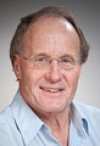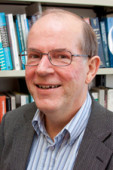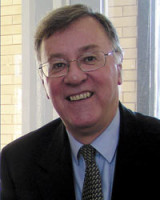2011 NIDEA Seminar Series
 Thursday November 17th, 2011
Thursday November 17th, 2011
1:10 - 2:30pm
K.G.01
Dr Yaghoob (Yaqub) Foroutan (NIDEA, The University of Waikato)
The Fateful Triangle: Gender, Migration, Religion
Abstract:
Using a demographic approach, this paper presents empirical evidence to discuss the association between ‘gender, migration, religion’, and explains how crucially these key determinants shape a triangle to affect identity. The discussion is based on two related studies. First, the results of a University of Waikato’ FASS funded research, which focuses on New Zealand population by migration status, ethnic origin, gender and religious affiliation during 1996-2006. Second, the discussion also uses the findings of a research conducted in Australia. It is worthwhile noting that the multiethnic and multicultural contexts of Australia and New Zealand holding a significant proportion of population from throughout the world with a wide range of cultures and religions operate as ‘a human and social laboratory’ in this sort of demographic analysis. Besides highlighting the demographic and socio-economic differentials between natives and migrants, both studies have given particular focus to those immigrants who experience a substantially greater ‘social and cultural distance’ (e.g. Berry 1992; Chiswick et al. 2003; Foroutan and McDonald 2008; Foroutan 2009) between the origin and destination societies. Accordingly, this cross-cultural analysis provides an opportunity in this discussion to deal more appropriately with the association between gender, migration and religion outlined above as the key objective of this research paper.
Speaker's Bio:
Dr Yaghoob (Yaqub) Foroutan completed his PhD in Demography at The Australian National University (ANU), Canberra, Australia. His doctoral research examining demographic patterns and determinants of women’s market employment with specific focus on the effects of migration, ethnicity and religion (particularly, Muslim immigrants) won The W. D. Borrie Essay Prize awarded by The Australian Population Association. He also holds a BA in Social Sciences, a MA in Sociology, and a MA in Demography from Tehran University. He has published extensively in peer-reviewed journals including Journal of Population Research, International Migration Review, Immigrants and Minorities, South Asia Research, Asian Journal of Women’s Studies, Australian Religion Studies Review, Fieldwork in Religion, Journal of Muslim Minority Affairs, and New Zealand Sociology. He also wrote a chapter on the association between gender and religion in the edited book titled The World’s Religions: Continuities and Transformations published by Routledge in 2009. Dr Foroutan is currently Postdoctoral Fellow at the National Institute of Demographic and Economic Analysis (NIDEA), the University of Waikato.
 Friday October 28th, 2011
Friday October 28th, 2011
3:00 - 4:15pm
S.G.03
Professor Philip Morrison (Victoria University of Wellington)
The Generational Switch in Suicide and Wellbeing
Abstract:
One of the most profound shifts in wellbeing within western countries over the last 50 years is reflected in the decline in the age specific rates of suicide among the old and their rise among the young. This ‘generational switch’ in suicide rates, which is particularly clear in New Zealand, raises important questions about the changing distribution of incentives for living across the age domain. The purpose of this paper is to suggest that while there are indeed proximal causes for suicide, there are also deep social influences and that both are reflected in contemporary measures of age-specific suicide and wellbeing. Our collective understanding of the changing relationship between the generations however still relies primarily on ‘comparison theory’. Further empirical understanding of intergenerational wellbeing raises a number of questions both about the kinds of data we collect in the future and how we might better reconstruct changes in wellbeing by age over the last half century.
Speaker's Bio:
Philip Morrison is Professor of Human Geography in the School of Geography, Environment and Earth Sciences, Victoria University of Wellington. He completed his PhD on housing markets under a Commonwealth Scholarship at the University of Toronto. Before his appointment at Victoria University of Wellington Philip held research positions at the Centre for Urban and Community Studies, University of Toronto, and the Department of Regional Science, University of Pennsylvania. He was awarded the first Hodge Fellowship by the Social Science Research Fund Committee in 1985 to study local labour markets and a Henry Lang Fellowship in 2002 by the Institute of Policy Studies to explore relationships between geography and social policy. His present focus on wellbeing and the geography of happiness is an extension of that project. Philip has been an Urban Studies Fellow at the Centre for Urban Studies, University of Glasgow and Visiting Fellow at the Department of Geography, University of Cambridge, as well as a number of Australian universities. More recently he received ISAT funding to study motives for internal migration at the University of California, Los Angeles. He is a member of the Regional Science Association International and is currently serving as the New Zealand ambassador for the U.K. based Regional Studies Association.
 Thursday October 13th, 2011
Thursday October 13th, 2011
1:10 - 2:30pm
S.G.03
Professor Jacques Poot (NIDEA, The University of Waikato)
Cities in 2050: Demographic Drivers of Global Urban Change
Abstract:
By the end of this month, the world population will have reached 7 billion, of which more than half live in cities. The growth of cities has led to extensive interest among economists during the last decade as it is becoming clear that powerful agglomeration forces are reinforcing the role of cities as the engines of economic growth and contributing to further rapid urbanisation. By 2050 more than two-thirds of the world population will live in cities. In this presentation I will use the recent UN population projections, combined with projections of global international migration, to show that by 2050 no corner of the world will be sheltered from sweeping demographic changes due to population ageing and population redistribution. Such changes will be amplified in cities that attract both migrants and provide for the needs of the elderly. Changes in urban demographic dependency ratios and urban diversity (resulting from international migration) will be compared across continents. Major implications will be highlighted.
Speaker's Bio:
Jacques Poot is Professor of Population Economics at NIDEA. Professor Poot was born in The Netherlands and has an MSc degree in econometrics from VU University in Amsterdam, and a PhD from Victoria University of Wellington. He is an Honorary Fellow of the Royal Netherlands Academy of Arts and Sciences and an adjunct professor at VU University Amsterdam. He is also an Associate of the Centre for Research and Analysis of Migration (CReAM) at University College London; and a Research Fellow, at IZA – Institute for the Study of Labor, Bonn. His teaching and research interests include a wide range of aspects of the economics of population. Professor Poot currently co-leads two large collaborative research projects: on the economic integration of immigrants in New Zealand, and on migrant diversity and regional disparity in Europe respectively.
Friday September 30th, 2011
1:10 - 2:00pm
MSB.0.01
Dr Sarah Baird (George Washington University), Craig McIntosh, Berk Özler
Cash or Condition? Evidence from a Cash Transfer Experiment
This NIDEA Seminar is held in collaboration with The Department of Economics, University of Waikato
Abstract:
This paper assesses the role of conditionality in cash transfer programs using a unique experiment targeted at adolescent girls in Malawi. The program featured two distinct interventions: unconditional transfers (UCT arm) and transfers conditional on school attendance (CCT arm). While there was a modest decline in the dropout rate in the UCT arm in comparison to the control group, it was only 43% as large as the impact in the CCT arm at the end of the two-year program. The CCT arm also outperformed the UCT arm in tests of English reading comprehension. However, teenage pregnancy and marriage rates were substantially lower in the UCT than the CCT arm, entirely due to the impact of UCTs on these outcomes among girls who dropped out of school.
Speaker's Bios:
Sarah Baird is an Assistant Professor of Global Health at George Washington University. She is a development economist whose work focuses on analyzing health issues in developing countries through careful program design and evaluation, with a focus on the health of infants and youth, as well as on issues related to HIV/AIDS. She has conducted field work in Vietnam, Kenya, Malawi and Tanzania. She received her Ph.D in Agricultural and Resource Economics at UC Berkeley in 2007 and has also been a post-doctoral fellow in the School of International Relations and Pacific Studies at UC San Diego.
Berk Özler is a Senior Economist in the Development Research Group, World Bank. He received his Ph.D in Economics from Cornell University in 2001. He is interested in policy issues that are salient in the developing world, including the effective design of cash transfer programs and HIV prevention among adolescent girls and young women. He is currently a co-PI for several randomized controlled experiments in Malawi and Tanzania. He is also one of the founders of the Development Impact blog: http://blogs.worldbank.org/impactevaluations/
 Tuesday September 27th, 2011
Tuesday September 27th, 2011
Dr Per Axelsson
Umeå University, Sweden
Indigenous Health - Global and Local Patterns
This NIDEA Seminar is held in collaboration with Te Kotahi Research Institute, University of Waikato
Abstract:
This seminar will outline the field of Indigenous health and address the limits and possibilities of investigating health effects of colonization in Sweden and Australia. The epidemiological transition that took place in the western world with the introduction of modern public health measures was crucial in reducing epidemic diseases and raising life expectancy, but these measures have benefitted non-Indigenous populations more than Indigenous peoples. Today it is well established that the health of Indigenous peoples worldwide compares unfavorably with that of their non-Indigenous counterparts. Gracey and King (2009) highlight in the introduction of their recent Lancet review on indigenous health that “we need to understand how colonization affected the lives of Indigenous peoples to understand their health today. The effect of colonization was and is profound” (Gracey and King 2009, 65).
Sweden and Australia are poles apart geographically, ecologically and also concerning the health of their Indigenous peoples. Even with documented threats such as high suicide rates among young reindeer herders, the Swedish Sami of today experience standards of living, life expectancy, and health equal to those of non-Indigenous Swedes. The scenario was different 150 years ago when infant and childhood mortality was three times higher and life expectancy was considerably lower among the Sami as compared to the settled population. The development of health and life expectancy among Swedish Sami represents one of few encouraging examples of a positive Indigenous health transition. On the other side of the scale are the Indigenous Peoples of Australia whose poor health and circumstances has led the Australian Federal Government to commit to ‘closing the gap’ of Indigenous disadvantage. A key target is to reduce the 17–year gap in life-expectancy between non-Indigenous and Indigenous Australians by half within one generation.
Speaker's bio:
Per Axelsson is a Dr. of History working at the Centre for Sami Research, Umeå University, Sweden. His areas of interest include longitudinal studies of indigenous health, effects of colonisation on the indigenous Sami people and the history of polio. Recent publications include; Global Environmental Change, International Journal of Circumpolar Health and co-editing the book Indigenous Peoples and Demography. The Complex Relation between Identity and Statistics. Oxford and New York, Berghahn Books(2011). He received Umeå University Young Researcher Award 2009 and is co-chair of the Family and Demography Network, European Social Science History Association. During 2011 Dr. Axelsson is a visiting scholar at the Centre for Health and Society at University of Melbourne performing collaborative work on the consequence of colonization on mortality and health in Sweden and Australia.
 Thursday September 15th, 2011
Thursday September 15th, 2011
1:10 - 2:30pm
S.G.03
Professor Peter McDonald
The Australian National University &
President of the International Union for the Scientific Study of Population
The Determinants of Australia's Future Population: with implications for New Zealand
Abstract:
In its recent policy report on population, the Australian Government concluded: it is more useful for governments, businesses and communities to focus on ways of improving our wellbeing, protecting our environment and making better use of the resources we have, rather than trying to determine an absolute limit to our population and focusing efforts on restricting growth in order to not exceed this ‘limit’. In doing so, it distanced itself not only from Kevin Rudd’s ‘big Australia’ statement but also from the voices calling for a ‘small Australia’. Peter McDonald argues that, after 12 months of debate characterized by a great deal of demographic nonsense, the Government’s statement was a welcome relief in that it recognized that the long-term, future population cannot be exogenously determined by policy makers but will be an endogenous outcome of social, economic and environmental determinants. He calls for much greater attention being focused upon more accurate estimates of population in the intermediate term, 10-20 years out. In the paper he discusses likely trends in this shorter time frame and ways that estimates can be improved.
Speaker's bio:
Peter McDonald is Professor of Demography and Director of the Australian Demographic and Social Research Institute at the Australian National University. He is President of the International Union for the Scientific Study of Population for the years, 2010-2013. He is frequently consulted on the issue of population futures (causes, consequences and policies) by governments around the world, especially in Australia, Europe and East Asia. In 2008, he was appointed as a Member in the Order of Australia. He is Deputy Director of the Australian Research Council Centre of Excellence in Population Ageing Research and a Fellow of the Academy of the Social Sciences in Australia.
 Thursday August 18th
Thursday August 18th
Professor Ian Pool
Emeritus Professor, NIDEA, The University of Waikato
Compression of Mortality and Health Expectancies in New Zealand: Policy Implications
Abstract:
The future trends of mortality and morbidity are one of the more hotly debated issues in demography. The reason is that different scenarios for mortality hold vastly different, and major, implications for health and other social policies. Today in most western developed countries (WDCs) indicators of national patterns of longevity and survivorship show that life expectancies (e(0)) are high and increasing, and that most children born alive can expect to survive to 65+ years (l(65)); in any cohort median ages at death are well above 70 years, and increasing. These two points are not in dispute. But, there are disputes over interpreting data on the upper quartile ages at death. These are also increasing, but improvements seem far more gradual than for medians, thus, some argue, producing “compression of mortality” -- a decreasing range of ages at which death occurs. Other leading commentators disagree with this scenario, instead arguing that longevity will extend significantly, with major increases also at the upper end, thus producing not compression but “extension”. Clearly, these two alternative scenarios hold very implications for the duration of time over which cohorts will require health and other social services. Fueling this debate even further are the projected effects of morbidity, with projected scenarios falling into three different categories: (1) some argue that morbidity is also becoming “compressed” -- that the ages at which survivors are first subject to severe or life-threatening disorders are also older and increasing, but are not increasing at the same pace at older ages, and thus that durations over which survivors require high cost health and other social services will become shorter ; (2) others see extension of longevity, but which will be accompanied by longer durations over which people will be subject to severe or life-threatening disorders; and (3) some argue that both mortality and morbidity will move in tandem (this is termed “dynamic equilibrium”). Clearly, trend (1), compression of morbidity, carries the policy implication that major health and other social service costs will be least severe; but, by contrast, (2), extension of morbidity, that they will be maximized. The analysis of both morbidity and mortality are confounded by measurement issues. Recent statistical developments allow the two different components – morbidity and mortality – to be combined in what are termed health expectancies (HE), a Sullivan observed prevalence life-table methodology. Because they are robust and well-tested, HEs are now a standard indicator prescribed by WHO and in EUROSTAT. Across the WDCs, national e(0)s and HEs are converging, and New Zealand fits this broad trend. But within countries there are marked social differences in e(0)s and, more importantly, in l(x)s -- the number in any cohort surviving to exact age x, especially through late middle ages (say between exact ages 45 and 70). As a result, however, at older ages there are few differences in HE(x) – in populations with poorer health status the older are “hardy survivors”, and this affects HE(x) s. This has major implications when social differences are examined. In turn, these are important determinants of the effectiveness of policies to reduce gaps in health status – how to achieve a convergence in survivorship over the late middle ages. The focus here will be on Maori-Pakeha gaps. A new methodology, applying true cohort l(x)s to HEs developed out of two decades of work at NIDEA and the PSC, will be presented to illustrate these points.
Thursday July 21st
Professor Natalie Jackson
Director of NIDEA, The University of Waikato
Māori and the Potential Demographic Dividend
Abstract:
The paper will connect a recently articulated concept known as the ‘demographic dividend’, with key features of Māori and non-Māori demography. The dividend arises as each population passes through a certain stage of its demographic transition, and the maximum proportion enters the key working and income-earning ages. The paper argues that while the dividend is conventionally held to have two components, there may be a third which will generate particular advantages for Māori. This component will arise in both absolute and relative terms as the relatively youthful Māori population co-exists alongside its structurally older counterpart. The paper proposes that the first such dividend may have already passed, but there remain many opportunities to ensure that its second and third windows of opportunity are opened.
 Wednesday July 27th
Wednesday July 27th
Dr Arthur Grimes
Adjunct Professor in the Department of Economics at the University of Waikato, Senior Fellow at MOTU, Chair of the Board of the Reserve Bank
Knowledge Workforce Developments across 10 Australasian Cities
This NIDEA Seminar was held in collaboration with The Department of Economics, The University of Waikato
Abstract:
This paper examines one key theme of modern spatial economics relating to city development: Do the major cities within and across countries increasingly attract a disproportionate share of knowledge intensive economic activities? We describe trends in shares of knowledge intensive economic activities within five major New Zealand and five major Australian cities, and interpret these trends in light of modern economic geography theories. The paper is mainly descriptive, filling an information gap in relation to trends in knowledge intensity across New Zealand and Australian cities. We also compare developments in Auckland’s industry knowledge intensity with those in eight European comparator cities. Since 1991, Auckland’s share of employment within knowledge intensive sectors has increased at a faster pace than all four comparator New Zealand cities and all five Australian comparator cities. These trends indicate that intra-country agglomeration forces have more than offset the inter-country agglomeration forces for Auckland. However the other four New Zealand cities have experienced lower growth in their knowledge intensive sector shares than the five Australian cities, a result that is consistent with the existence of agglomeration forces acting across Australasia.
Friday June 3rd
Len Cook
Ex-government statistician of both NZ and Britain
Demography and Public Policy: General Themes and Recent Experiences in New Zealand
Abstract:
The political challenges of New Zealand's changing demography.
Tuesday March 22nd
Professor Richard Slaughter
Director, Foresight International
Welcome to the Anthropocene
This NIDEA Seminar was held in collaboration with the International Global Change Institute
Abstract:
'Welcome to the Anthropocene' addresses some of the themes in Professor Slaughter's new book, 'The Biggest Wake Up call in History', among them humanity’s careless use of its world, its technology, its flora and fauna and each other.
Speaker's bio:
Professor Slaughter is Director of Foresight International. During 2001-2005 he was President of the World Futures Studies Federation. He is the author or editor of some 20 books and many papers on a variety of futures topics. Two of his most recent works are: Futures Thinking for Social Foresight (2006) and The Biggest Wake Up Call in History (2010). He was recently voted one of ‘the best all-time Futurists’ by members of the Foresight Network, Shaping Tomorrow.
